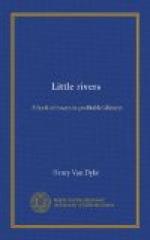The name of the Lake of the Beautiful Trout made us desire to visit it. The portage was said to be only fifty acres long (the arpent is the popular measure of distance here), but it passed over a ridge of newly burned land, and was so entangled with ruined woods and desolate of birds and flowers that it seemed to us at least five miles. The lake was charming—a sheet of singularly clear water, of a pale green tinge, surrounded by wooded hills. In the translucent depths trout and pike live together, but whether in peace or not I cannot tell. Both of them grow to an enormous size, but the pike are larger and have more capacious jaws. One of them broke my tackle and went off with a silver spoon in his mouth, as if he had been born to it. Of course the guides vowed that they saw him as he passed under the canoe, and declared that he must weigh thirty or forty pounds. The spectacles of regret always magnify.
The trout were coy. We took only five of them, perfect specimens of the true Salvelinus fontinalis, with square tails, and carmine spots on their dark, mottled sides; the largest weighed three pounds and three-quarters, and the others were almost as heavy.
On our way back to the camp we found the portage beset by innumerable and bloodthirsty foes. There are four grades of insect malignity in the woods. The mildest is represented by the winged idiot that John Burroughs’ little boy called a “blunderhead.” He dances stupidly before your face, as if lost in admiration, and finishes his pointless tale by getting in your eye, or down your throat. The next grade is represented by the midges. “Bite ’em no see ’em,” is the Indian name for these invisible atoms of animated pepper which settle upon you in the twilight and make your skin burn like fire. But their hour is brief, and when they depart they leave not a bump behind. One step lower in the scale we find the mosquito, or rather he finds us, and makes his poisoned mark upon our skin. But after all, he has his good qualities. The mosquito is a gentlemanly pirate. He carries his weapon openly, and gives notice of an attack. He respects the decencies of life, and does not strike below the belt, or creep down the back of your neck. But the black fly is at the bottom of the moral scale. He is an unmitigated ruffian, the plug-ugly of the woods. He looks like a tiny, immature house-fly, with white legs as if he must be innocent. But, in fact, he crawls like a serpent and bites like a dog. No portion of the human frame is sacred




